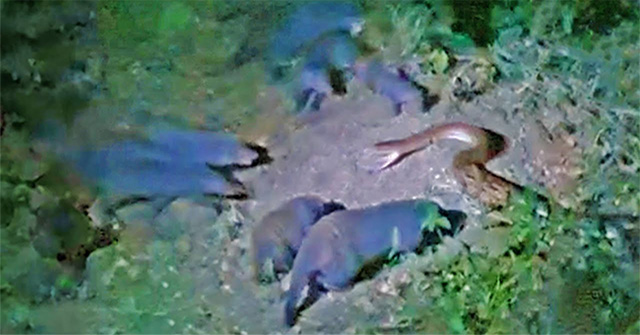
Witnesses Capture Rare Attack
Pierre Nel, a visitor to Marloth Park, witnessed a remarkable attack by a group of more than 20 mongooses on a python, reported Latest Sightings on April 24. Nel and his wife were drawn to the scene by an unusually intense chorus of squeals and growls piercing the quiet night. Using the light from their phones, they traced the sounds to the sight of what appeared to be an all-out assault on the massive snake.
Relentless Assault
Nel's account describes the mongooses relentlessly attacking the python from every angle. Some darted in to deliver swift bites, while others clawed at its scales. In stark contrast, the python offered no resistance, seemingly aware of its overwhelming odds.
Protecting the Family
The mongooses, fiercely protective of their young, displayed no fear towards the python. A few audaciously confronted its deadly head and fangs, while others relentlessly attacked its body. Banded mongooses are common prey for a variety of predators. Their small size forces them to rely on numbers for strength. They fiercely defend their territory and young, often attacking threats until they retreat or perish.
Narrow Escape
After enduring the assault, the python recognized its vulnerability and sought refuge. It retreated to the shelter of a small tree trunk, tucking its head safely out of reach of the mongooses but leaving its body exposed. The mongooses hesitated only momentarily before renewing their attack. The python seized the opportunity to slither away into the dense undergrowth. The mongooses momentarily gathered, watching it disappearing into the bushes before dispersing.
About Banded Mongooses
Banded mongooses are cat-sized, measuring only 12 to 18 inches long with an additional 12-inch tail, according to the Smithsonian's National Zoo and Conservation Biology Institute. While largely insectivores, their diet primarily consists of millipedes and beetles. They are opportunistic feeders and will consume birds, eggs, snails, fruits, and snakes as well.
These highly social animals live in groups of up to 20 individuals, with a dominant male at the helm. Despite their solitary foraging habits, they share communal responsibilities such as predator defense and snake hunting.
Defensive Alliance
When facing threats, mongoose mobs rally, employing synchronized defense to protect vulnerable members. Their boldness and cooperative behavior make them formidable adversaries. Any predator attempting to target a member is likely to encounter the unwavering wrath of the entire group.
Banded mongooses have been known to use a defensive tactic called "mobbing," where they encircle and harass predators, moving rhythmically and vocalizing to appear as a larger, more threatening opponent.
